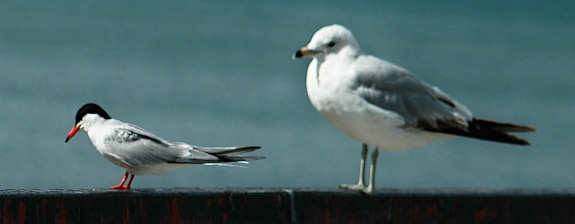May 22, 2025 8:33 am
Often Mistaken For Seagulls
Terns Are Remarkably agile and Acrobatic

Hover Craft
One good tern is a delight to watch!
During the season when the small fry come downstream in their imprinted trek to the open waters, the estuary is the place I am drawn to.
That is my starting point.
There is so much joy I experience from watching terns… do their thang.
Terns to an untrained eye can be overlooked and mis-labeled as seagulls, or seagully-type-thingys.
Really though, there is little to know to be able to distinguish the two, to make the brain tell the eye… that’s a tern….. and that’s a seagull.

tern vs seagull
Seagulls look clumsy, slow and a-few-sandwiches-short-of-a-picnic, when comparing them to slick looking terns. Even when compared to the Caspian terns that bulk up to the gulls size and bigger.
Don’t get me wrong I respect all of natures’ species, but I may not like many [probably most -esp. in the bad bacteria pool] -but respect bro!
Gulls have their place in nature.
More on them in a later post.
The terns at the estuary are Forsters, Common and the Caspian Tern.
The Forsters and Common terns often fly at roughly the same height, ten to twenty-five feet from the surface of the estuary. I have often noticed the Caspian terns 10-20 feet higher. All of them looking for that silver-white, under belly flash of twisting fry below the surface.

Spread ’em
Before the digital explosion, my choice of camera medium was 35 mm positives -slide film. Kodachrome and Ektachrome for color , Agfa for black and white. My first 35 mm digital camera had a crop frame sensor.
The lenses were mixed, [Fx] for full-frame sensors and [Dx] for cropped frame sensors. You can interchange them but the image on the sensor will differ. This can cause speed and exposure adjustments.
For a guide that may further your understanding.
Having been so used to using manual mode for many years, my brain did not adapt to what my eyes were telling it. I desired to show both qualities of motion blur and sharpness with the pose I wanted. Working this process out took effort and a large box-full of mistakes.
The mistakes were on me -I own them.
We are built to learn from them. My time-curve took a week or more with every days shoot being tossed in the virtual burial ground also known as trash bin.
Then it kinda clicked!

Seizing Moment
The terns patrol the last hundred meters of the creek eyes peeled in moving sniper fashion. Then hover with head down and beak aimed at the glistening target.
Locking in , the wings fold up and their body shape is perfect fo drop beak-point-first into the water with a minimum splash-field.
The success rate on returning to the surface with a catch is quite high, over 75%.
The exit is powered with strength, agility and competence, followed with a vibrating dog-shake to rid themselves of the trapped water in their down and feathers. The odd occasion witnessing the exit completely up-side down and fly in that fashion for several wing-beats before the barrel roll returns them to the right-side up.

Up and Away
There is often a celebratory squawking by some individual terns, probably the more juvenile, that signals a triumphant dive and catch.
Moreover, there are some terns with shortened stubby beaks that may signify a mis-judgement of water depth, the beak having taken the brunt of the mistake.
They will live!
The seagulls watch the patrolling and dive bombing routine with the occasional attempt themselves.
It’s not flattering.
The timing, speed and agility does not appear to be programmed into their DNA. I have never witnessed a successful seagull attempt, only awkward and clumsy belly-flops.
That should not induce a smile on my face, and with sincere apologies, it does.
But kudos to them that try, and for keeping the beaches clean of left-over picnic sandwiches!
I love the terns at the estuary.
comment .. below
Register / Login required to comment

